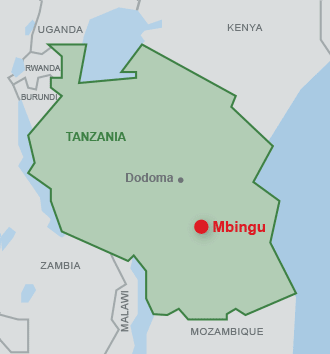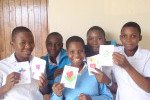
St. Martin’s Girls Secondary School is located outside Ifakara in a rural area marked by subsistence farming. Thanks to the boarding facilities, girls are spared the long daily walk to and from school and the exhausting daily work on their parents’ farm. St. Martin is exclusively for girls, because they have much less chance than boys of obtaining a higher level of education in Tanzania. The school is in need of external support because it helps many girls from the poorest families with their fees.
Facts and Figures
St. Martin’s Girls Secondary School
Mbingu
Morogoro-Region
Tanzania
2004; with government recognition in 2009
Augustina Mtanga, Director
14 qualified teachers
over 250 young women from Mbingu and the surrounding area
- A complex of buildings on land belonging to the diocese, consisting of large classrooms, a lab for science subjects, a kitchen with a covered area for eating, a staff room, library, administrative office as well as dormitories, toilets and showers for the young women
- Adequate accommodations for the teachers
- Garden and fields for growing vegetables, maize, rice and bananas. Other areas where trees are grown for wood and cocoa to contribute to the school’s finances
- Animals and their stalls: ducks, hens, pigs, goats and cows
- Second hand off-road vehicle for local transport
- Solar plant (electric generator as backup)
- 4 secondary classes (“Form 1-4”)
- Government recognition of the school and of girls’ examination results on national exams
- Boarding facilities
- Medical care; Extracurricular activities: sports, singing, dancing
CHF 74’000.– (2025) for school operations and scholarships
CHF 200’000.– (2025) for infrastructure
EEF support since 2012
Officially recognised secondary certificate for young women. Orphans and girls from poor families receive scholarships
The Project
Background
St. Martin’s Girls Secondary School is located in Mbingu, a village surrounded by numerous small settlements. Ifakara, the next bigger town, is about two hours away by car. The region is agricultural in nature and the majority of inhabitants are subsistence farmers, growing maize and rice. Despite recent major efforts on the part of the government in the field of education, there are still too few schools and not enough teachers to handle the rapid growth in population taking place in Tanzania.
Although Tanzanian secondary schooling has officially been free since 2016, many parents are unable to pay for the extra expenses such as uniforms, transport, school books or accommodation near a secondary school. Moreover, secondary schools in rural areas are still scarce. Children from low-income backgrounds who cannot afford transport often have a very long walk of up to fifteen kilometres per way. What makes things even more difficult for them is the lack of time and light to do their homework in the evening.
Tradition and culture influence parents to send their sons to school rather than their daughters, who often stay at home and work or try their luck in one of the larger cities or marry young, without hope of vocational training and their own income.
The project so far
St. Martin’s Girls Secondary School is located on land belonging to the Mahenge Sisters, a Catholic order who in 2004 opened the “Mahenge Sisters Education Center”, which at first offered preparatory classes and later secondary education to locals. The influx of new students, both boys and girls, quickly demonstrated that there was considerable demand for an affordable secondary school with a quality of instruction that would give students a good chance of gaining a national diploma.
This development did not go unnoticed at the Tanzanian Ministry of Education, which in 2009 granted official recognition and registered it as a private school in the Tanzanian system. Augustina Mtanga, a local Tanzanian teacher, became principal and the school’s name was changed to St. Martin’s Girls Secondary School. The new name indicated an important change in direction for the school, namely that from that point on it would accept only girls as new students.
From the beginning, a key goal was to offer more and better schooling to local children. Thus, the school is open to girls of all religions, and the student body is equally divided between Catholic, Protestant and Muslim girls. All girls live at the boarding school during the school terms.
The compound belonging to the Mahenge Sisters is made up of a number of buildings that have gradually been built since the founding of the diocese. Besides a convent there is a health centre, a metal workshop and a carpenter’s workshop. These structures formed the basis for opening the secondary school in a building complex temporarily made available by the diocese. In cooperation with the EEF, the sisters succeeded in constructing the first stage of a new complex for St. Martin’s Girls Secondary School in 2019. This new infrastructure thus offers much better conditions for teaching and accommodation for the young women. The school is allowed to use surrounding fields and gardens for the cultivation of food for self-sufficiency, with the pupils helping with the work in the fields during harvest time. The school uses further land for animal husbandry and for the cultivation of products (construction timber and cocoa) that will provide the school with more funds of its own in the future.
Success and challenges
St. Martin’s Girls Secondary School enjoys an excellent reputation and demand for places is therefore high. The students’ final results are outstanding, thanks to the considerable efforts of the staff. And, since comparable schools in Tanzania are few and far between, girls come to remote Mbingu from far away to receive a high quality education. Such success has however also led to an increase in students and consequent strains on the infrastructure, resulting in a number of provisional solutions.
A boarding school offers many advantages. Girls can be supervised round the clock. They have the opportunity to study in the evening, which improves their school performance. Regular sports events as well as a balanced diet and medical care improve their health. A boarding school also offers safety and security, helping to prevent early pregnancies. These are important prerequisites for finishing secondary school successfully.
Given its remote location, it is a challenge for the St. Martin Secondary School to retain its well-qualified teaching staff over a longer period of time. Thanks to donations to the equal education fund (EEF), it was possible to build sufficient accommodation for all teachers by early 2016. Since then, the teaching staff has remained virtually unchanged. Continuing education courses also help to improve teaching methods and keep teachers highly motivated.
According to the project concept, mainly girls from the region are given access to this secondary school. The school fees are calculated to be affordable for an average family in the area. However, if a girl’s parents still cannot pay the costs in full, the project concept entails that this should not prevent her from attending secondary school. The fees for these girls are therefore reduced, which in turn reduces the income of the school. Accordingly, in order to guarantee the school’s finances and also to maintain the social aspect of the project, the EEF supports St. Martin’s with scholarships for disadvantaged local girls.
Goals
To enable girls to receive a good quality secondary education. Special conditions are offered to young women from the area whose families are unable to pay the fees, so that they can also benefit from the school’s instruction.
To improve the students’ performance by offering boarding accommodation, and to promote their physical and mental development with health care, a balanced diet and opportunities for mentoring, sports and games.
To realise our plan, which shows how the school, after completion of an investment phase, can attain financial independence and at the same time fulfil its social commitments to girls from Mbingu.
Support by the EEF
The equal education fund’s (EEF) contact to St. Martin’s Girls Secondary School arose through a Baldegg Sister. Born in Tanzania, she taught there for several years before coming to Switzerland in 1963. Once here in Switzerland, she studied at university – partly with an EEF member – and taught at a Swiss state school (gymnasium). In 2004 she returned to Tanzania to help with the founding of the Mbingu school. The equal education fund began direct support for the Mbingu project in May 2012, after obtaining a detailed picture of the school through a visit. The EEF board then decided to concentrate its support on scholarships for local girls who could not pay their school fees. For this, the financial situation of the families is checked annually as is their level of need.
A further focal point of cooperation is support for administrative matters, particularly those related to reporting. The EEF introduced a bookkeeping system and revised the way receipts were handled. These instruments allowed a clearer overview of expenditure and income. They also provided the basis for working out a plan by which the school can attain financial independence from the EEF
Since the original provisionally used buildings did not comply with all state requirements for a school infrastructure, a new St. Martin’s Secondary School had to be built. In addition to supporting the construction of teachers' accommodation and the electrification of the school with a solar power system, the EEF was also able to help finance half of the first stage of this new buildings thanks to generous donations and contributions. The other half was raised by the school's owner, the Mahenge Sisters’ Congregation. In 2019, the school started operating in the new buildings. The land reserves available here allowed for an expansion of the infrastructure.
FFollowing some stagnation in demand in 2020 and 2021, more parents asked for a place at the school for their daughter again in 2022. EEF is therefore helping to increase the school’s capacity with additional buildings. This will enable St. Martin’s Girls Secondary School to increase its level of self-sufficiency. Thus, together with the school’s own fundraising and proceeds from agriculture, it will be self-sustaining in the future.
Tanzania
67,4 million inhabitants (estimate 2024)
945’090 km²
(nearly twenty-three times the size of Switzerland)
CHF 3’000.– (2023, adjusted for purchasing power)

Prices in Mbingu (as of June 2019)
- 1 litre of petrol:CHF 1.25
- 1 litre of milk:CHF –.75
- 1 litre of Coca-Cola:CHF –.75
- 1 kilo of bread:CHF 1.35
- 1 kilo of rice:CHF –.55
- 1 cinema ticket:CHF –.25 (Football match in a bar. There is no cinema.)
- 1 pack of cigarettes:CHF 3.–
- 1 bar of soap:CHF –.20
Sources:
World Bank, CIA World Factbook, information from Augustina Mtanga, own design and calculations.
Video
Project presentation
Gallery
_gallery_teaser.jpg?lm=1745438705)
Tanzania St. Martin's Girls Secondary School Picture Gallery 2024
view album
_gallery_teaser.jpg?lm=1718999637)
Tanzania St. Martin's Girls Secondary School Picture Gallery 2023
view album
_gallery_teaser.jpg?lm=1686895958)
Tanzania St. Martin's Girls Secondary School Picture Gallery 2022
view album
_gallery_teaser.jpg?lm=1650541394)
Tanzania St. Martin's Girls Secondary School Picture Gallery 2021
view album
_gallery_teaser.jpg?lm=1612791658)
Tanzania St. Martin's Girls Secondary School Picture Gallery 2020
view album
_gallery_teaser.jpg?lm=1581069327)
Tanzania St. Martin's Girls Secondary School Picture Gallery 2019
view album
_gallery_teaser.jpg?lm=1571925347)
Tanzania St. Martin's Girls Secondary School Picture Gallery 2018
view album
_gallery_teaser.jpg?lm=1571924806)
Tanzania St. Martin's Girls Secondary School Picture Gallery 2017
view album
_gallery_teaser.jpg?lm=1571924333)
Tanzania St. Martin's Girls Secondary School Picture Gallery 2016
view album
_gallery_teaser.jpg?lm=1571923805)
Tanzania St. Martin's Girls Secondary School Picture Gallery 2015
view album
_gallery_teaser.jpg?lm=1571923397)
Tanzania St. Martin's Girls Secondary School Picture Gallery 2014
view album

Tanzania St. Martin's Girls Secondary School Picture Gallery 2013
view album
_gallery_teaser.jpg?lm=1571922775)
Tanzania St. Martin's Girls Secondary School Picture Gallery 2012
view album
_gallery_teaser.jpg?lm=1571922581)
Tanzania St. Martin's Girls Secondary School Picture Gallery before 2012
view album
